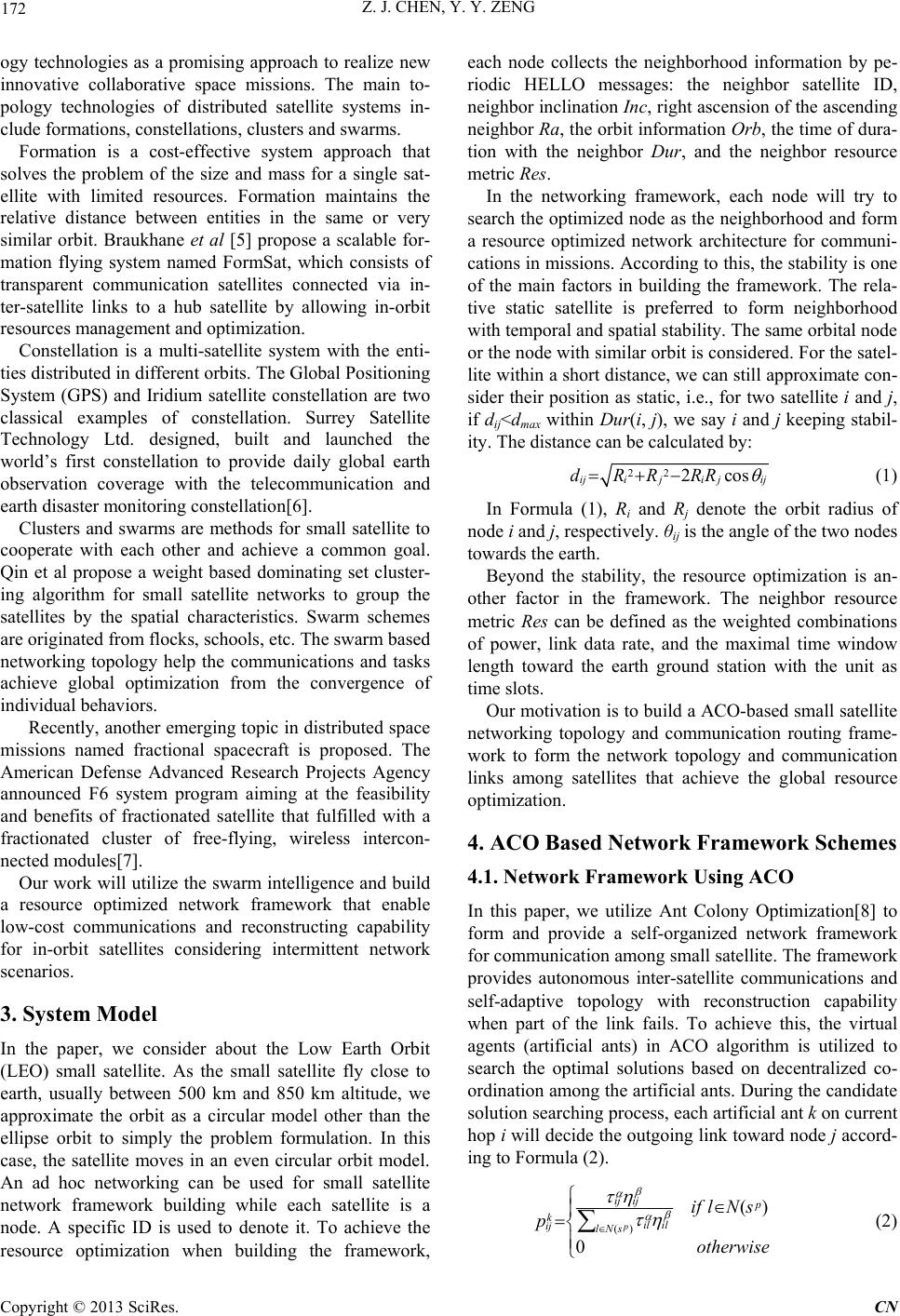
Z. J. CHEN, Y. Y. ZENG
172
ogy technologies as a promising approach to realize new
innovative collaborative space missions. The main to-
pology technologies of distributed satellite systems in-
clude formations, constellations, clusters and swarms.
Formation is a cost-effective system approach that
solves the problem of the size and mass for a single sat-
ellite with limited resources. Formation maintains the
relative distance between entities in the same or very
similar orbit. Braukhane et al [5] propose a scalable for-
mation flying system named FormSat, which consists of
transparent communication satellites connected via in-
ter-satellite links to a hub satellite by allowing in-orbit
resources management and optimization.
Constellation is a multi-satellite system with the enti-
ties distributed in different orbits. The Global Positioning
System (GPS) and Iridium satellite constellation are two
classical examples of constellation. Surrey Satellite
Technology Ltd. designed, built and launched the
world’s first constellation to provide daily global earth
observation coverage with the telecommunication and
earth disaster monitoring constellation[6].
Clusters and swarms are methods for small satellite to
cooperate with each other and achieve a common goal.
Qin et al propose a weight based dominating set cluster-
ing algorithm for small satellite networks to group the
satellites by the spatial characteristics. Swarm schemes
are originated from flocks, schools, etc. The swarm based
networking topology help the communications and tasks
achieve global optimization from the convergence of
individual behaviors.
Recently, another emerging topic in distributed space
missions named fractional spacecraft is proposed. The
American Defense Advanced Research Projects Agency
announced F6 system program aiming at the feasibility
and benefits of fractionated satellite that fulfilled with a
fractionated cluster of free-flying, wireless intercon-
nected modules[7].
Our work will utilize the swarm intelligence and build
a resource optimized network framework that enable
low-cost communications and reconstructing capability
for in-orbit satellites considering intermittent network
scenarios.
3. System Model
In the paper, we consider about the Low Earth Orbit
(LEO) small satellite. As the small satellite fly close to
earth, usually between 500 km and 850 km altitude, we
approximate the orbit as a circular model other than the
ellipse orbit to simply the problem formulation. In this
case, the satellite moves in an even circular orbit model.
An ad hoc networking can be used for small satellite
network framework building while each satellite is a
node. A specific ID is used to denote it. To achieve the
resource optimization when building the framework,
each node collects the neighborhood information by pe-
riodic HELLO messages: the neighbor satellite ID,
neighbor inclination Inc, right ascension of the ascending
neighbor Ra, the orbit information Orb, the time of dura-
tion with the neighbor Dur, and the neighbor resource
metric Res.
In the networking framework, each node will try to
search the optimized node as the neighborhood and form
a resource optimized network architecture for communi-
cations in missions. According to this, the stability is one
of the main factors in building the framework. The rela-
tive static satellite is preferred to form neighborhood
with temporal and spatial stability. The same orbital node
or the node with similar orbit is considered. For the satel-
lite within a short distance, we can still approximate con-
sider their position as static, i.e., for two satellite i and j,
if dij<dmax within Dur(i, j), we say i and j keeping stabil-
ity. The distance can be calculated by:
22
2cos
ijiji jij
dRRRR
(1)
In Formula (1), Ri and R
j denote the orbit radius of
node i and j, respectively. θij is the angle of the two nodes
towards the earth.
Beyond the stability, the resource optimization is an-
other factor in the framework. The neighbor resource
metric Res can be defined as the weighted combinations
of power, link data rate, and the maximal time window
length toward the earth ground station with the unit as
time slots.
Our motivation is to build a ACO-based small satellite
networking topology and communication routing frame-
work to form the network topology and communication
links among satellites that achieve the global resource
optimization.
4. ACO Based Network Framework Schemes
4.1. Network Framework Using ACO
In this paper, we utilize Ant Colony Optimization[8] to
form and provide a self-organized network framework
for communication among small satellite. The framework
provides autonomous inter-satellite communications and
self-adaptive topology with reconstruction capability
when part of the link fails. To achieve this, the virtual
agents (artificial ants) in ACO algorithm is utilized to
search the optimal solutions based on decentralized co-
ordination among the artificial ants. During the candidate
solution searching process, each artificial ant k on current
hop i will decide the outgoing link toward node j accord-
ing to Formula (2).
()
()
0
p
ij ij
kil il
ij lNs
if lNs
p
otherwise
(2)
Copyright © 2013 SciRes. CN